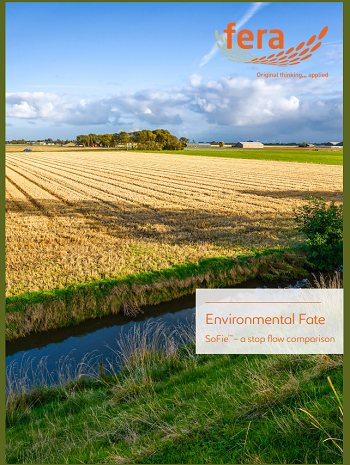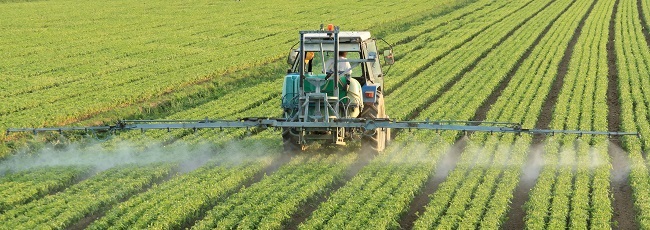"Our routine tests can be adapted to suit your particular data requirements"

Visit our other sites
-
Fapas - Proficiency Testing
Globally recognised provider of proficiency tests, running over 400 tests annually across an extensive range of matrices and analytes
-
Great Crested Newts Testing
A single sample taken by an ecologist at any time during the newt breeding season can determine their presence or absence, saving you time and money
- Fera can support the environmental fate (eFate) testing requirements of your agrochemicals development programme in our state-of-the-art laboratories using sediments, soils and natural waters.
- Find out more

Fera has developed its research area of environmental risk assessment into a robust commercial regulatory service which delivers to agrochemical, veterinary medicine, human pharmaceutical, biocides and general chemical industries. Within the eFate team, Fera has 6 study directors, and a further 30 operational staff GLP and IRR17 compliant.
Fera delivers routine and bespoke efate studies where good science is paramount. We pride ourselves in fully supporting our clients from the study design, implementation to the dossier submission and response phases. This ensures our clients are fully supported during technical discussions.
Fera has the best people in the right place focussed on delivering the right solution. We continuously invest in our people and support them in delivering the best science to our partners.

Phil Rooney
Phil is the senior environmental fate scientist for chemical safety at Fera with 10 years’ experience in the area. With a background in biochemistry, Phil manages commercial and research projects within the environmental fate and behaviour sector. Phil performs the role of study director for highly technical studies as well as manages a large team of GLP study director’s working on a variety of chemical classes and regulations.

Carmel Ramwell
Carmel specialises in environmental and human exposure to chemicals in the wider environment, including urban and residential areas and leads our activities relating to the fate and behaviour of plant toxins in the environment. Carmel is also proficient in investigating the impact that agri-environment schemes and other policy drivers have on soil/water quality and ecosystem services.
Environmental fate ebook

Fera’s environmental fate studies include a range of regulatory compliant tests to assess the biodegradation of chemicals in soil and water. By understanding how chemical products are broken down and degraded in the natural environment,we can supply the data you need for your environmental risk assessments – ensuring you meet all regulatory requirements in the development of safe new chemical products.
With improved capacity of 300%, as more parent-associated metabolite fate studies become necessary, we can offer the entire spectrum of laboratory and higher-tier environmental fate studies with more efficient turnaround times.
Our investment in our HPLC lab provides customers with a more efficient and cost effective service. With our SoFie™ modules we can detect smaller levels of radioactivity due to the stop-flow mechanism. With improved sensitivity of signal to noise SoFie™ gives better counting statistics without adversely affecting the chromatography.
Download the Environmental Fate ebook here
Our Services - Environmental Fate Studies
| Efate Studies | Description |
|---|---|
| Adsorption – Desorption using a Batch Equilibrium Method (OECD 106) | The purpose of this test is to estimate the adsorption/desorption behaviour of a substance on soils. Therefore, the adsorption (binding of a chemical to surfaces of soils) of a test substance on different soil types will be evaluated. The decrease in concentration when aqueous solutions of the test item are in contact with different soil types at room temperature will be determined. |
| Hydrolysis as a function of pH (OECD 111) |
The purpose of this test is to determine the rate and route of hydrolysis on a chemical exposed in aqueous solutions at different pH value (e.g. pH 4, 7 and 9) under sterile conditions. After appropriate time intervals the solutions are analysed for the test item and hydrolysis products. With the use of a radiolabelled compound a mass balance would be established. |
| Ready Biodegradability – CO2 in sealed vessels (Headspace Test) (OECD 301) |
Biodegradation is one of the most important factors in assessing the environmental fate of chemicals. Substances coming into the aquatic environment via waste water get in contact with the sewage treatment microorganisms, which is therefore the basis for the assessment of aquatic biodegradation. |
| Aerobic and Anaerobic Transformation in Soil (OECD 307) | The purpose of this test is to measure the time course of biodegradation of a test substance in soil under aerobic and anaerobic conditions and to quantify the observations in the form of kinetic rate expressions. Degradation of the test substance will be followed for the parent substance and its potential (known) transformation products. Degradation rate, mass balancing and transformation product pattern will be determined for the test substance. Degradation kinetics will also be followed for any major transformation product, if possible. |
| Aerobic and Anaerobic Transformation in Aquatic Sediment Systems (OECD 308) | The purpose of this test is to measure the time course of biodegradation of a test substance in aquatic sediment systems under aerobic and anaerobic conditions and to quantify the observations in the form of kinetic rate expressions. Degradation of the test substance will be followed for the parent substance and its potential (known) transformation products. Degradation rate, mass balancing and transformation product pattern will be determined for the test substance. Degradation kinetics will also be followed for any major transformation product, if possible. |
| Aerobic Mineralisation in Surface Water– Simulation Biodegradation Test (OECD 309) | The purpose of this test is to measure the time course of biodegradation of a test substance at low concentration in aerobic natural water and to quantify the observations in the form of kinetic rate expressions. Degradation of the test substance will be followed for the parent substance and its potential (known) transformation products. Degradation rate, mass balancing and transformation product pattern will be determined for the test substance. Degradation kinetics will also be followed for any major transformation product, if possible. |
| Phototransformation of Chemicals in Water – Direct Photolysis (OECD 316) |
Direct photolysis involves the transformation of a chemical resulting from direct absorption of a solar photon. Direct photolysis can be an important dissipation pathway for a chemical that exhibits significant light absorption above 290 nm cut-off of the solar irradiation at the earth´s surface. The purpose of this test is to investigate the potential effects of solar irradiation on the test substance in water. Direct photolysis rate, half-life and quantum yield will be determined for the test item. The transformation product pattern and mass balance can be investigated with the usage of 14C-labelled test item. |
| Aged sorption studies (SANTE/12586/2020) |
At the lower tier of exposure assessment we assume that sorption is instantaneous and fully reversible which implies that sorption coefficients are constant over time. However, we know that sorption in soil increases gradually over time and it is not possible to say where fast sorption finishes and slow sorption starts, it is a continuous process that slows down over time. The purpose of this test is to quantify the slow adsorption process that can happen over a period of weeks-months and generate from the experimental data the parameters necessary to allow refinement of concentrations during exposure modelling. |
| Determining Anaerobic Transformation of Chemicals in Liquid Manure (OECD 320) and Fate of veterinary medicinal products in manure (CVMP 2011) |
When livestock are intensively housed veterinary medicinal products (and feed additives and biocides) will enter the environment following the application of animal manures to land as soil improvers. The purpose of this test is to simulate the fate a behaviour of chemicals in the manure when stored on farm to determine the rate of degradation (i.e. DT50) and the transformation products that maybe formed. These studies are commonly performed with poultry litter, pig slurry and cattle manure. |
| Uptake of chemicals by plant roots (ECPA/IVA) |
The purpose of this study is to determine the potential for a chemical to be taken up by plant roots and the potential to be translocated to shoots. The hydroponic experimental design using plant seedlings and radiolabelled test chemicals can generate parameters which allow exposure modelling to refined for this process of the reduction in chemical concentration in the soil profile. |
| OECD DRAFT - Soil Photolysis | The purpose of this test is compliance with the proposed new guidelines for phototransformation of chemicals in soil surfaces. Man-made chemicals may reach soil directly via deliberate application or via indirect routes as chemicals can be transformed in soil by microbial, chemical and/or photochemical processes. |
Download our New Factsheets on Available Studies
Experience the ultimate interactive map and virtual tour of Fera

Copyright © 2025 Fera Science Limited (“Fera”). All rights reserved.
For further information about how Fera uses any personal data collected from you, please see our Privacy Notice at www.fera.co.uk/privacy-policy.










